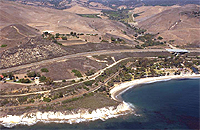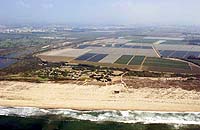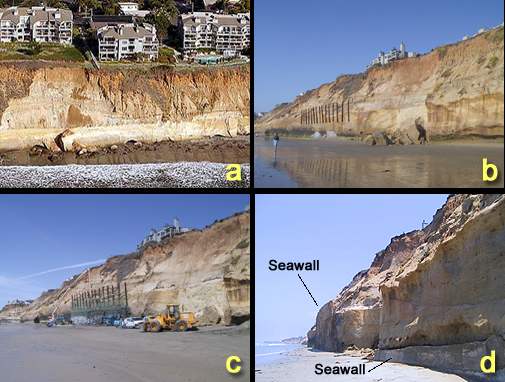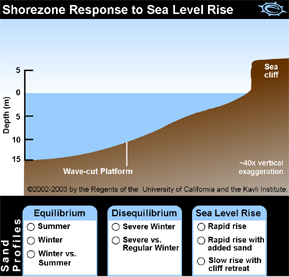To Nourish or Armor?
 here southern California beaches are wide, they usually are artificially nourished.
here southern California beaches are wide, they usually are artificially nourished.
 Artificial nourishment at Santa Monica pier and beach, Santa Monica Cell, Los Angeles County. |
 Artificial nourishment at Hotel del Coronado groin and beach, Silver Strand Cell, San Diego County. |
 Narrow beach at Refugio, In the western Santa Barbara littoral cell. Santa Barbara County. |
 Wide beach at McGrath State Beach,
Wide beach at McGrath State Beach,In the eastern Santa Barbara Cell, Ventura County. |
| All images copyright © 2002-2004 Kenneth Adelman, California Coastal Records Project, www.californiacoastline.org. Images used with permission. | |
Over 100 million cubic meters of sand have been supplied from harbor and other coastal construction projects since 1930. Santa Monica and Coronado beaches received most of this "opportunistic" sand supply, and beach widths increased several hundred meters. Continuing nourishment will maintain beach width.
Elsewhere along the southern coast, beaches are narrow and sand starved (see Refugio image).
Naturallly wide beaches exist only downdrift of the Santa Clara River mouth near Ventura (see McGrath Beach) and Oxnard. But even these beaches receive dredged material from Ventura Harbor.
Now is the most favorable time to increase beach nourishment.
Southern California appears to be entering the dry phase of climate that historically has lasted 20-30 years. Under dry conditions, storms are less intense and sand stays in the littoral cell longer so we receive more value from the nourishment dollar. Nourished beaches increase coastal protection, promote tourism and beach recreation, provide habitat, and build resilience for future climate changes.
• Mitigating the Hazards of Coastal
Bluff Instability in San Diego County
If we let beaches remain sand-starved, we lose that resiliency. The beach is more rapidly eroded during storms, and it will take much greater volumes of sand to restore it. As waves attack the sea cliffs, there will be intense pressure to armor the coast in order to protect public infrastructure and private property.

Before, during and after seawall construction at Solana Beach.
Images, b, c & d: Photographer - Pat Masters.
Image a: Copyright © 2002-2004 Kenneth Adelman, California Coastal Records Project, www.californiacoastline.org. Images used with permission.
Balancing the need to protect sea cliffs and property with the need to maintain beaches

Groin field, Ventura County.
Groins are designed to slow longshore transport, but
they are unsightly and may pose hazards to swimmers,
surfers, and boaters. Photographer - Gary Griggs.
Image used with permission.
Coastal property owners in southern California are justifiably worried about bluff failures. Coastal bluffs erode at the toe of the cliff due to wave action, but they also fail because of grading, irrigation, and other disturbance from construction activities too close to the edge of the bluff. In some areas, inherent structural weaknesses also lead to slumping and collapse. When sea cliffs collapse or storms damage low-lying structures, property owners seek some form of structural protection.
Most shore protection structures such as seawalls reflect wave energy rather than dissipating energy as an equilibrium beach does. Dissipative structures such as rock riprap occupy beach space and constrain the beach's ability to establish equilibrium. Other structures such as groins trap sand locally but increase downdrift erosion. New technology may eventually improve the performance of coastal structures, but for the present most shore structures cause beach erosion unless artificial nourishment is also provided.
Additionally, structures are costly to build and maintain. In California and other parts of the country where coastal policy discourages seawalls and other structures, the permitting process is stringent and time-consuming.
But armoring the coast does nothing to restore beaches. It is important to keep in mind that an equilibrium beach dissipates all the wave energy and protects the base of the cliff. A wide beach also shelters low-lying coasts from waves and flooding. Clearly, beach restoration benefits property owners as well as those who use and enjoy the beach.
Coastal erosion and property values
• Coping with Coastal Erosion:
Evidence for Community-Wide Impacts
Kriesel, W. and Friedman, R., 2003.
(PDF format, ~22Mb)
To learn more about beach restoration:
• California Beach Restoration Study
2002
• Beach Nourishment and Protection:
A Report by the National Research
Council, National Academy of
Sciences, 1995
According to a study commissioned by the Federal Emergency Management Agency, beach replenishment increases property values for property owners on the waterfront and for owners a few rows inland, creating total community benefits higher than typically calculated. On the other hand, shore protection structures benefit only the waterfront owners, while lowering property values for inland owners. But this benefit is temporary -- as more of the shoreline is armored, waterfront property values also decline.
Making it possible
State, regional, and local agencies can seek federal funds to restore beaches. Unfortunately, California has lagged behind many other states in securing federal appropriations for beach restoration projects.

Data from Marlowe & Company.
What will happen with sea level rise?
In the long run, attempts to hold the sea cliff become more problematic as sea level rises. Cliff retreat allows the platform to adjust to sea level and if it can't, the beach is drowned and lost.
Beach nourishment makes more sense than armoring at this time. It delivers instant protection, increases recreational and aesthetic values, and provides resiliency for future climate conditions. And over the next decade or two, a milder wave climate may be working in our favor by decreasing rates of beach erosion.
The future of California's coast ... it's our choice.
©2002-2004 by the Regents of the University of California and the Kavli Institute.
All rights reserved.
Last modifed Thursday September 23, 2004


